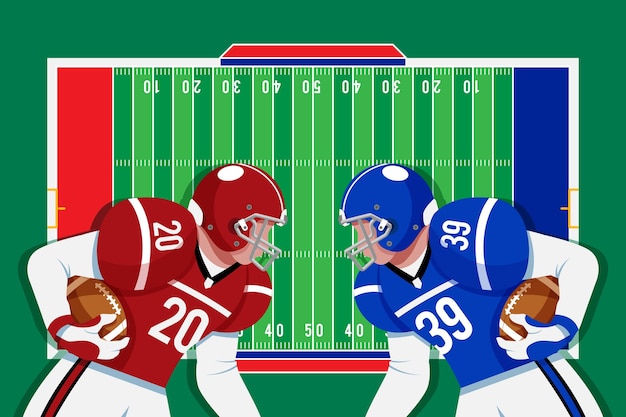Anúncios
As I sit down to dissect the exhilarating world of the NFL draft, I’m struck by the immense significance of that coveted first pick. The pressure surrounding this selection isn’t just about choosing a player; it’s about shaping the future of an organization. Statistically, teams securing the first pick enjoy a notably higher success rate in playoff appearances over the next few seasons, which underscores the critical nature of this moment.
In the fiercely competitive atmosphere of the draft, strategies must be sharp, calculated, and adaptive. Renowned analysts emphasize that preparation is key; spending the right amount of time evaluating potential players can mean the difference between mediocrity and greatness. This article will unravel the complexities of mastering the first pick draft game, providing insights and recommendations for teams and fans alike.
Anúncios
Understanding the NFL Draft Process
The NFL Draft is a critical event in American football, drawing widespread attention each year as teams vie for the next generation of talent. It typically occurs in April, with teams meticulously planning their strategies months in advance. The draft consists of seven rounds, in which teams select eligible college players. The first round is particularly significant, as it sets the tone for the entire draft and allows teams to secure the most promising athletes.
Every team desires the coveted first pick, often considered a game-changer in building a successful roster. The structure of the draft is designed to maintain competitive balance, allowing teams with poor previous seasons to select earlier. This system intensifies the focus on the first pick, making it a pivotal moment in the hopes of transforming a franchise’s future.
Leading up to the draft, teams conduct extensive evaluations, including the NFL Scouting Combine and individual pro days, giving them critical insights into player potential. The anticipation of who will be selected first creates a buzz among fans and analysts alike, heightening the stakes as teams finalize their choices. Ultimately, the NFL Draft is not just about selecting talent; it’s about strategic positioning and shaping a team’s trajectory in the league.
Anúncios
Strategies for Selecting the First Pick
Moreover, understanding team needs plays a pivotal role. It’s imperative to align the choice with the current roster strengths and weaknesses, addressing gaps that could hinder future success. This approach involves open communication amongst coaches, scouts, and management to establish a cohesive strategy.
Trade potential is another crucial aspect. Teams should explore opportunities to trade down, maximizing asset value while addressing multiple needs. This allows for flexibility, as acquiring multiple draft picks can yield advantageous options in later rounds. Balancing risk and reward is critical; evaluating whether to secure a high-impact player or trade for additional resources requires careful consideration.
Lastly, maintaining adaptability throughout the process is vital. The draft landscape can shift unexpectedly due to trades or player performances during pro days. Teams that remain agile and responsive to these changes hold a significant advantage, ensuring their first pick holds strategic value for both the present and future.
Analyzing Top Prospects

Inspirational Insight
“Success is no accident. It is hard work, perseverance, learning, studying, sacrifice, and most of all, love of what you are doing or learning to do.” – Pelé
This quote by Pelé encapsulates the essence of what it takes to succeed, especially in a demanding arena like the NFL. Just as teams evaluate players’ hard work and dedication through various metrics, individuals must also commit to their craft, continuously learning and adapting. The pursuit of excellence in football—or any field—hinges on passion and resilience, mirroring the intense scrutiny and evaluation that prospects undergo in preparation for their big break.
Impact of the First Pick on a Franchise
Explore Key Draft Strategies for NFL Success
Understanding the intricacies of NFL Draft strategies can significantly impact a team’s future outcomes. For an in-depth look at how successful teams approach their first picks, visit: NFL – Draft Strategy Tips.
Common Mistakes in Draft Preparation
Preparing for the first pick draft game can often lead teams into a labyrinth of common mistakes that can derail their strategies. One of the most significant pitfalls is overvaluing individual performance metrics without considering team dynamics. Teams must remember that the successful integration of a player into their existing roster is vital. Analyzing not just statistics, but how a player fits the cultural and tactical needs of the team is paramount.
Another frequent error is neglecting the value of trade opportunities. Many teams focus solely on their selection without contemplating how trading down could net additional picks, allowing for better long-term planning. Evaluating the draft board deeply can uncover these opportunities.
Moreover, teams sometimes overlook the importance of thorough scouting reports. Relying on surface-level analysis can be detrimental. Comprehensive evaluations of a player’s character, work ethic, and potential for growth are essential to making informed choices.
Communication within the draft team is another area where mistakes occur. Failing to align on shared objectives can create discord and lead to poor decision-making. Teams should ensure that all members are on the same page regarding strategy and risk tolerance.
Finally, rushing the decision-making process often results in hasty choices. It is crucial for teams to allow themselves the time to deliberate thoroughly, weighing every potential outcome. By recognizing and avoiding these common pitfalls, teams can improve their chances of a successful first pick.
Key Insights for Successful Draft Strategies
Understanding the intricacies of draft decisions can significantly enhance team performance.
